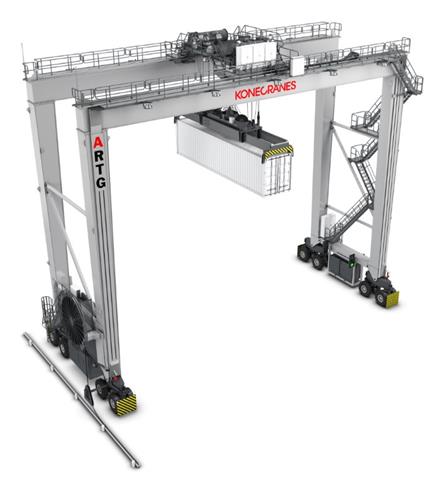 Konecranes' rubber-tyred gantry crane |
Guatemala's Terminal de Contenedores Quetzal SA (TCQ) has ordered five 16-wheel rubber-tyred gantry (RTG) cranes from Konecranes PLC of Hyvinkää, Finland for delivery in late 2015. Terms were not disclosed.
Grup Marítim TCB SL of Barcelona, Spain owns TCQ among its 13 terminals in several countries. The TCQ order will become Konecranes' sixth delivery to a Grup TCB terminal and the first to Guatemala.
"Grup TCB has been working with Konecranes for a number of years and appreciates the high performance and reliability of Konecranes RTGs," says Juan José Suarez, TCQ general manager. "This track record was an important factor in this purchase decision."
Each diesel-powered RTG has a lifting capacity of 40 T. and can stack one-over-five containers high, and seven-plus-truck-lane wide. Each will be equipped with Konecranes' active load control technology, advanced fuel saver technology and Truconnect-brand remote diagnostics.
The greenfield TCQ project involves development of a dedicated state-of-the-art container terminal within the existing Port of Quetzal. The terminal will begin operations with an annual capacity of 350,000 20 ft.- (6 m-) equivalent units and will operate under a 25-year lease agreement with Empresa Portuaria Quetzal, the state-owned company that owns and administers the port. Quetzal was artificially created through coastal reclamation in the 1980s and is the only container port on the Pacific Ocean coast of Guatemala, about 1.5 hours' drive from Guatemala City.
In February, the board of the Washington, DC-based International Finance Corporation (IFC), a member of the World Bank Group, approved an investment of up to USD44.7 million, including a loan of USD35 million and an equity infusion of USD9.7 million. The port project is estimated to cost approximately USD177 million.
Plans call for construction of a 350 m quay with 12 m draft suitable for handling post-panamax vessels, installation of cargo handling equipment including eventually two ship-to-shore cranes and six rubber-tyred gantry cranes and development of the terminal's supporting backup areas and infrastructure